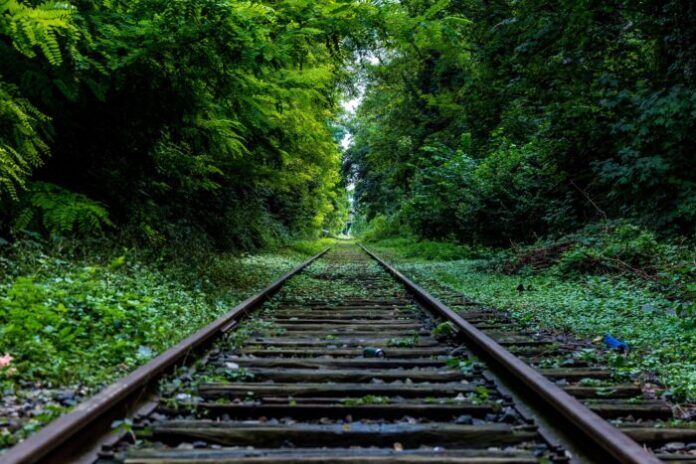
An old disused railway, a breathtaking landscape and a visionary recovery project: these are the ingredients that led to the creation of a cycle path between the Appennino Lucano and Pollino National Parks.
The old railway was conceived at the end of the 19th century to connect the existing Cosenza-Sibari and Sicignano-Lagonegro sections; the first section was inaugurated in 1915 and connected Spezzano Albanese to Castrovillari. The most difficult part to build, between Laino Borgo and Morano Calabro, was completed in 1931, bringing to a conclusion the Spezzano Albanese-Lagonegro section.
The railway was already abolished in the 1950s due to structural failures, but was completely decommissioned only in 1984 with the removal of the tracks. In 2020 the cycle path that goes from Lagonegro to Viggianello and Rotonda was inaugurated, which is destined to connect to the other cycle paths that in the future should connect other areas of Basilicata.
Following the ancient tracks, the itinerary to be traveled by bicycle passes through various tunnels and various villages. From Lagonegro we move towards Lauria, passing through the Sirino lake; once you reach the town of Lauria, the old railway is lost for a while and it will be necessary to take the provincial road towards Laino Borgo, although a short stretch can be traced for a few hundred meters.
Continuing the route, you reach the woods on the border with Calabria and cross the same regional border, reaching the town of Laino Borgo. It is a small town in the heart of the Pollino National Park, with a very characteristic landscape. The territory is in fact crossed by the Lao and Iannello rivers; in particular, the Lao River crosses a large canyon about 200 meters deep. Rafting and river sports enthusiasts can enjoy the great beauty of the numerous caves and waterfalls on both shores.
Above Laino Borgo stands the abandoned town of Laino Castello, currently undergoing renovation. The old castle is characterized by the presence of a small village and is located on top of Colle San Teodoro. Already in the 1960s it was decided to move the town to another place due to some seismic phenomena and hydrogeological problems; after the 1980 earthquake, the population was forced to permanently abandon the ancient village.
The itinerary continues towards Mormanno, even if in this section the traces of the old railway are not yet passable due to the current state of neglect. The village, founded in the Lombard age, is characterized by a typically medieval layout with narrow stone-paved streets, stairways, arches and ancient stone portals; there are numerous churches and noble palaces. On the spur of Monte San Michele is the Votive Lighthouse, a monument erected in 1928 in honor of the fallen of the Calabria Region during the First World War; it is used as a reference point for air navigation.
After having traveled for a short distance the old Lagonegro-Spezzano Albanese railway, transformed into a cycle / pedestrian, it is necessary to return to the asphalted road. With your gaze turned to the summit of Dolcedorme, the highest peak of the Pollino, you descend towards the town of Morano Calabro, one of the most beautiful villages in Italy. Going up the alleys of the Borgo, through churches and stately buildings, you reach the top of the ruins of an ancient Castle; built on the remains of a Roman outpost by the Normans, it assumed its present form in the 16th century with the enlargements carried out on behalf of Prince Sanseverino. Not far away is the church of San Pietro e Paolo, dating back to the year 1000, whose interior has been renovated in a late Baroque style.
Resuming the old railway, in this section transformed into an asphalted cycle path, the route moves towards Castrovillari. As a last stop you can head to Civita, a well-known arbëreshe community, even if here the railway has been partly canceled by urbanization and partly incorporated into the provincial road and in the cultivated fields of private property. Along the way you will come across the Raganello Gorge Nature Reserve; the latter constitute a canyon about 17 km long that goes from the Lamia source to the town of Civita, where the Ponte del Diavolo is located, then flowing towards the mouth.
The village of Civita is characterized by the presence of the Kodra houses, built between 1600 and 1700; they are all equipped with windows that look like eyes, flues that look like noses and doors that give the idea of a mouth. In essence, these houses recall a human face, even if not all of them have a chimney or the same dimensions of the elements. They were called Kodra houses because they recall the style of an Albanian Cubist painter, Ibrahim Kodra, who visited the country in the 1990s.
Thus ends a fascinating journey, which brings together in a single great emotion the beauty of the landscape, the recovery of history and the enhancement of what could simply be left in the oblivion of time.



































